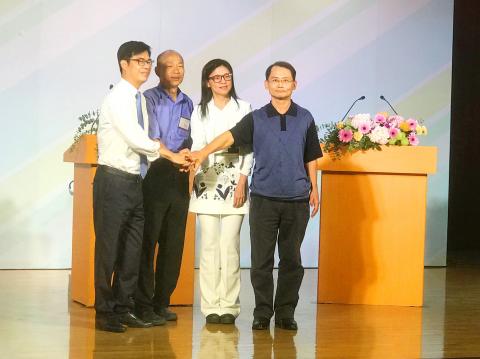Economic issues dominated a live TV “platform presentation” by the two main candidates in the Kaohsiung mayoral race yesterday.
Democratic Progressive Party Legislator Chen Chi-mai (陳其邁) said that Kaohsiung, the largest city in southern Taiwan, should try to strengthen its economy.
Developing tourism is one way to do so, he said.

Photo: copy by Ko Yu-hao, Taipei Times
Chen said he would improve Kaohsiung’s economy by developing the city as an Asian transportation hub, given its advantageous geographic location.
He said he would develop the high-tech industry in the city by building a semiconductor cluster and a technology corridor, while also encouraging an upgrade of the old economy sector so that it would become more competitive.
Chen also said he would also focus on green energy and a circular economy.
Chinese Nationalist Party (KMT) candidate Han Kuo-yu (韓國瑜) said that Kaohsiung, once a jewel in Taiwan’s crown, is a sleeping giant whose economy has slowed down over the past two decades.
The time has come for the giant to awaken, Han said.
Kaohsiung has an advantage in aviation and sea transportation, as well as promising fishing and agricultural industries, Han said, adding that it should build on those strengths.
However, many people in Kaohsiung have lost hope due to long-term economic stagnation, while the city’s population is shrinking, he said.
The city needs a new mayor to lead its economic revival, so the giant can rise up again, Han said.
Kaohsiung also needs a new leader to solve the problems that have caused the economic slowdown and to make it more attractive to investors, he said, adding that the biggest challenge for the next mayor would be to make Kaohsiung great again.
“I will lead Kaohsiung into the future as a youthful town, a rich town,” Han said. “People coming to Kaohsiung will say it is a huge city, fun to visit and even easier to make money in.”
In response to Shu Te University dean Chen Ching-yao (陳清燿), who asked how he intends to implement his platform, Chen Chi-mai cited his three-month term as acting mayor of then-Kaohsiung City in 2005 as evidence of his efficiency.
During his term, Chen said he demonstrated his ability to stand firm, to execute policies and to negotiate when he facilitated the city government’s retention of piers by staging talks between Taiwan International Ports Corp’s Kaohsiung branch, the Taiwan Railways Administration and the Ministry of National Defense.
However, Han said it was more important to cultivate trust among people.
If a majority of residents is angry and distrustful of the government, no policy, regardless how good or well-intentioned, could be pushed through, Han said.
The presentation also included independent candidates Chu Mei-feng (璩美鳳) and Su Ying-kuei (蘇盈貴), who lag far behind Chen and Han in opinion polls.

ANOTHER EMERGES: The CWA yesterday said this year’s fourth storm of the typhoon season had formed in the South China Sea, but was not expected to affect Taiwan Tropical Storm Gaemi has intensified slightly as it heads toward Taiwan, where it is expected to affect the country in the coming days, the Central Weather Administration (CWA) said yesterday. As of 8am yesterday, the 120km-radius storm was 800km southeast of Oluanpi (鵝鑾鼻), Taiwan’s southernmost tip, moving at 9kph northwest, the agency said. A sea warning for Gaemi could be issued tonight at the earliest, it said, adding that the storm is projected to be closest to Taiwan on Wednesday or Thursday. Gaemi’s potential effect on Taiwan remains unclear, as that would depend on its direction, radius and intensity, forecasters said. Former Weather Forecast

As COVID-19 cases in Japan have been increasing for 10 consecutive weeks, people should get vaccinated before visiting the nation, the Centers for Disease Control (CDC) said. The centers reported 773 hospitalizations and 124 deaths related to COVID-19 in Taiwan last week. CDC Epidemic Intelligence Center Director Guo Hung-wei (郭宏偉) on Tuesday said the number of weekly COVID-19 cases reported in Japan has been increasing since mid-May and surpassed 55,000 cases from July 8 to July 14. The average number of COVID-19 patients at Japan’s healthcare facilities that week was also 1.39 times that of the week before and KP.3 is the dominant

The Chinese Communist Party’s (CCP) working group for Taiwan-related policies is likely to be upgraded to a committee-level body, a report commissioned by the Mainland Affairs Council (MAC) said. As Chinese President Xi Jinping (習近平) is increasingly likely to upgrade the CCP’s Central Leading Group for Taiwan Affairs, Taiwanese authorities should prepare by researching Xi and the CCP, the report said. At the third plenary session of the 20th Central Committee of the CCP, which ended on Thursday last week, the party set a target of 2029 for the completion of some tasks, meaning that Xi is likely preparing to

US-CHINA TRADE DISPUTE: Despite Beijing’s offer of preferential treatment, the lure of China has dimmed as Taiwanese and international investors move out Japan and the US have become the favored destinations for Taiwanese graduates as China’s attraction has waned over the years, the Ministry of Labor said. According to the ministry’s latest income and employment advisory published this month, 3,215 Taiwanese university graduates from the class of 2020 went to Japan, surpassing for the first time the 2,881 graduates who went to China. A total of 2,300 graduates from the class of 2021 went to the US, compared with the 2,262 who went to China, the document showed. The trend continued for the class of 2023, of whom 1,460 went to Japan, 1,334 went to